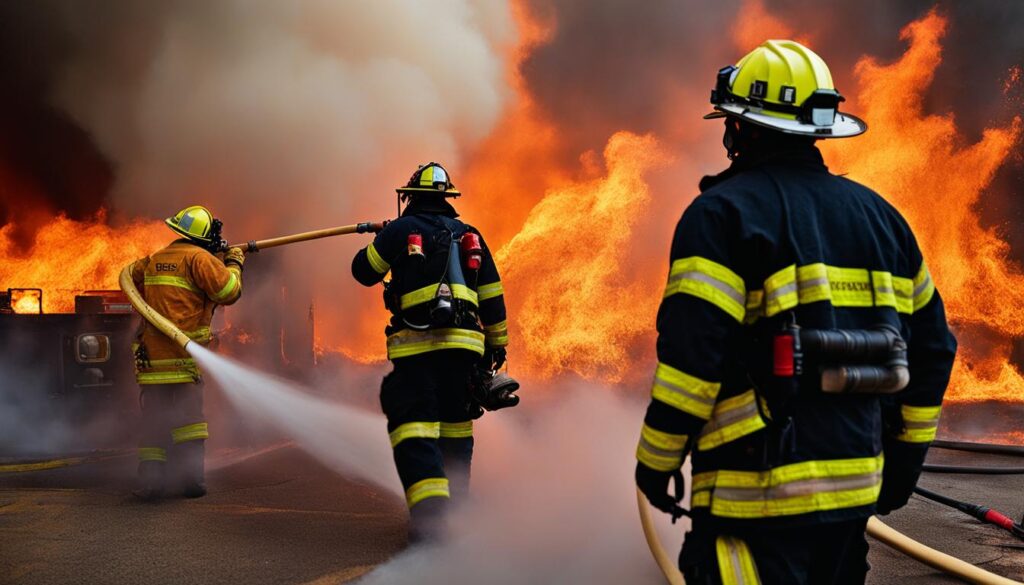Are you familiar with the essential components of an emergency voice alarm communication system? How does this system ensure safety and effective communication during emergencies? Discover the key features and benefits of a voice evacuation system that plays a vital role in facilitating orderly evacuations and communication during critical situations.
Key Takeaways:
- An emergency voice alarm communication system, also known as an EVCS, is a bidirectional system designed for real-time communication during emergencies.
- The system enables communication between different points within a building, such as control rooms, fire wardens, and stewards.
- EVCS assists with the orderly evacuation of disabled or mobility impaired individuals and facilitates communication between firefighters.
- It is particularly useful in the early stages of evacuation before the arrival of the fire and rescue service.
- The system also allows individuals with mobility impairments to communicate their presence and receive assistance during emergencies.
Intended Uses for an EVCS
An emergency voice alarm communication system (EVCS) has various valuable applications during emergency situations. The system supports efficient communication between different points of a building, including the control room and fire wardens or marshals stationed on different floors. This seamless communication enables them to relay critical information to the control center, such as the status of floor clearance.
Once the fire and rescue service arrives, they assume control of the evacuation process. The EVCS continues to play a pivotal role in facilitating communication between fire officers at the control center and those on the ground, ensuring effective coordination throughout the evacuation operation.
During fire fighting, the EVCS remains indispensable for the fire and rescue service. It allows them to maintain communication channels, ensuring fluid coordination and the swift implementation of firefighting tactics.
Furthermore, the EVCS provides a lifeline for disabled individuals or those who are unable to use traditional escape routes. They can communicate directly with the control center, seeking guidance and assistance necessary for their safe evacuation.
EVCS Uses:
- Enabling communication between the control room and fire wardens or marshals
- Facilitating communication between fire officers at the control center and those on the ground
- Supporting fire and rescue service operations during fire fighting
- Providing a means of communication for disabled individuals or those with limited mobility
With the critical role it plays in emergency communication and coordination, an EVCS ensures that safety protocols are upheld and that individuals are efficiently guided to safety during fire emergencies.

Disabled Refuge and its Requirements
A disabled refuge serves as a designated safe area within a building, providing a temporary place of safety for individuals who may have difficulty using fire escapes or evacuation lifts during an emergency. It ensures that disabled or mobility-impaired individuals can wait for assistance until building management and emergency services can safely evacuate them from the building. Disabled refuges are required in all non-domestic premises with multiple floors or where emergency exits are accessed by stairs.
These refuges are especially crucial in buildings where there are disabled individuals or those who may have difficulty navigating the evacuation route. They enable these individuals to find safety and wait for help during an emergency situation. Each stairway in the building should have a refuge area that is accessible to wheelchairs, meeting specific design requirements for accessibility and safety. These areas should have a minimum size requirement and direct access to the stairway.
The disabled refuges must be clearly identified with appropriate fire safety signs, ensuring that individuals can easily locate them in times of need. It is important to note that disabled refuges should always remain available, even in the absence of a fire emergency, to ensure the safety and well-being of those who may require their use.
<!–
–>
Disabled refuges play a crucial role in promoting inclusivity and ensuring the safety of all individuals within a building. By providing a designated safe area and meeting specific design requirements, these refuges contribute to a comprehensive emergency evacuation plan, allowing for the effective evacuation of disabled or mobility-impaired individuals during emergencies.
Fire Telephones and Emergency Assist Alarms
Fire telephones are essential hardwired communication systems that play a vital role in ensuring the safety of occupants in tall buildings. They serve as a backup method of communication when traditional fireman’s radio systems may be hindered by the structure. In compliance with regulations, fire telephones are required in buildings with more than four storeys. These systems facilitate communication between different points within a building, enabling swift and efficient emergency response.
Emergency assist alarms are another crucial component of building safety, specifically in non-domestic premises. These alarms are imperative in disabled toilets, providing assistance to individuals in need. To enhance efficiency, these alarms can be seamlessly integrated with Emergency Voice Alarm Systems (EVCS). This integration allows all calls related to disabled communication to be consolidated and displayed at a central point, ensuring prompt assistance is provided when required.
All fire telephones and emergency assist alarms must adhere to the necessary requirements and meet relevant standards. Regular maintenance and testing of these systems are imperative to ensure their functionality during emergencies. By complying with regulations and conducting routine checks, building owners and managers can foster a safe and secure environment for their occupants.
FAQ
What is an emergency voice alarm communication system?
An emergency voice alarm communication system, also known as an EVCS, is a bidirectional system that allows for real-time communication during emergencies in various facilities. It facilitates communication between different points within a building, such as control rooms, fire wardens, and stewards.
What are the uses of an EVCS?
An EVCS is used to facilitate communication between the control room and fire wardens or marshals during the initial stages of evacuation. It also supports communication between fire officers at the control center and other officers on the ground when the fire and rescue service arrives. The system is also utilized throughout the course of a fire to assist in fire fighting. Additionally, it enables disabled individuals or those unable to use escape routes to communicate with the control center for guidance and assistance.
What is a disabled refuge?
A disabled refuge is a designated safe area within a building where individuals who cannot easily use fire escapes or evacuation lifts can wait for assistance during the evacuation process. It provides a temporary place of safety until building management and emergency services can safely evacuate them from the building.
When is a disabled refuge required?
Disabled refuges are required in all non-domestic premises with more than one storey or where emergency exits are accessed by stairs. They are also necessary in buildings where there are disabled individuals or those who may have difficulty navigating the evacuation route.
What are the requirements for a disabled refuge?
Each stairway should have a refuge area that is accessible to wheelchairs, with a minimum size requirement and direct access to the stairway. The refuge areas should be clearly identified with appropriate fire safety signs and should remain available at all times, even when there is no fire emergency.
What are fire telephones?
Fire telephones are hardwired communication systems required in buildings over four storeys. They provide a backup communication method to traditional fireman’s radio systems and facilitate communication between different points within a building, especially in high-rise environments where radio broadcasts can be impaired.
What are emergency assist alarms?
Emergency assist alarms are required in all disabled toilets within non-domestic premises to provide assistance to those in need. These alarms can be integrated with the EVCS, allowing all calls related to disabled communications to be displayed in a single point.
How often should fire telephones and emergency assist alarms be maintained and tested?
All fire telephones and emergency assist alarms must comply with relevant regulations and standards and should be regularly maintained and tested.
Source Links
- https://www.apefireandsecurity.co.uk/a-beginners-guide-to-emergency-voice-communication-systems/
- https://www.ifsecglobal.com/fire-features/emergency-voice-communication-systems-what-are-they-and-what-do-you-need-to-know/
- https://marlowefireandsecurity.com/solutions/compliance/emergency-voice-communication-system-evcs/
